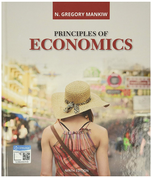Solution Found!
Explaining Economic Logic of Purchasing-Power Parity
Chapter 31, Problem 4(choose chapter or problem)
Questions & Answers
QUESTION: Describe the economic logic behind the theory of purchasing-power parity.
ANSWER:Step 1 of 2
The theory of purchasing-power parity is based on a principle called the law of one price. This law asserts that a good must sell for the same price in all locations. Otherwise, there would be opportunities for profit left unexploited.
The theory of purchasing-power parity (PPP) is based on the economic logic that in the long run, exchange rates between two countries' currencies should adjust to equalize the purchasing power of those currencies. It suggests that the relative prices of identical goods and services in different countries should be similar when expressed in a common currency.
Watch The Answer!
Explaining Economic Logic of Purchasing-Power Parity
Want To Learn More? To watch the entire video and ALL of the videos in the series:
This video explains the theory of Purchasing Power Parity (PPP) in economics, emphasizing how it relies on the "law of one price" and illustrating how exchange rates should adjust to equalize purchasing power between nations in the long run. It also demonstrates how price disparities for products like iPhones can lead to currency exchange rate adjustments and eventually equalized prices.
